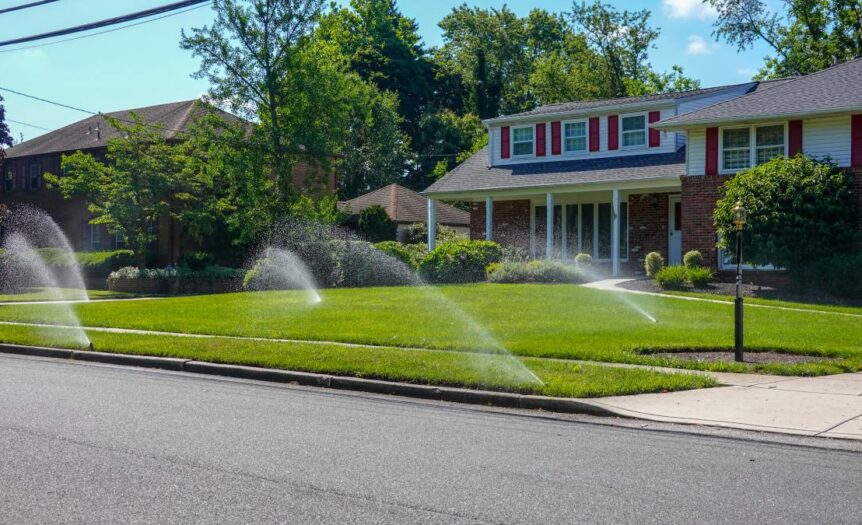A lush, green lawn or a thriving garden doesn’t happen by accident; it requires consistent and effective watering. Home irrigation systems are the unsung heroes that ensure your plants receive the hydration they need, even when Mother Nature doesn’t cooperate.
But with a few different systems available on the market, navigating the world of irrigation can be daunting. Whether you’re a seasoned gardener or a novice plant parent, understanding the different types of home irrigation systems can help you achieve the vibrant landscape you’ve always dreamed of.
Sprinkler Irrigation Systems
Sprinkler irrigation systems are perhaps the most recognizable type of home irrigation. These systems simulate natural rainfall by distributing water through a network of pipes and sprinkler heads. One of the primary pros of sprinkler systems is their ability to cover large areas uniformly, making them ideal for expansive lawns and gardens.
However, they can be less water-efficient compared to other systems, particularly in windy conditions where much of the water may evaporate or drift away. Additionally, sprinkler systems may not be suitable for plants that are prone to fungal diseases, as overhead watering can create a moist environment conducive to such issues.
Drip Irrigation Systems
Drip irrigation systems offer a more targeted approach to watering your plants. These systems deliver water directly to the base of each plant through a series of tubes, emitters, and valves. By delivering water directly to the root zone, it minimizes evaporation and runoff, making it an excellent option for water conservation. Plus, drip systems can reduce the likelihood of fungal diseases since the foliage remains dry.
However, maintenance is an important consideration; these systems can be prone to clogging, especially if the water source contains sediments or minerals. Regular checks and cleaning are necessary to keep the system running smoothly. Moreover, drip systems may not be as effective for large areas such as expansive lawns, where the intricate network of tubes and emitters can become cumbersome to manage.
Micro-Irrigation Systems
If you’re looking for an irrigation system that will make your neighbors jealous of your lawn, consider a micro irrigation system. These systems use small emitters that release water at a slow and steady rate, precisely targeting the plant’s root zone. Similar to drip irrigation, it minimizes water waste through evaporation and runoff, ensuring that each plant receives just the right amount of hydration. Micro-irrigation is highly customizable, allowing gardeners to tailor the water delivery based on individual plant needs and soil conditions, which is particularly beneficial for garden beds and mixed plantings.
However, micro-irrigation systems also demand ongoing maintenance, as emitters can clog easily due to mineral buildup or debris. Additionally, while micro-irrigation is ideal for smaller, concentrated areas, it may be less practical for larger lawns. The detailed network of small tubes and emitters could turn into a tangled mess, becoming more of a hassle than a help for those maintaining spacious green areas.
Understanding the different types of home irrigation systems and their unique advantages and challenges allows you to make informed decisions to nourish your plants and even lower your water bill. So go ahead and take the plunge into the world of home irrigation—your plants (and wallet) will thank you!










 Deering Estate
Deering Estate
 Massage Envy South Miami
Massage Envy South Miami
 Calla Blow Dry
Calla Blow Dry
 My Derma Clinic
My Derma Clinic
 Sushi Maki
Sushi Maki
 Sports Grill
Sports Grill
 The Healthy Kitchen
The Healthy Kitchen
 Golden Rule Seafood
Golden Rule Seafood
 Malanga Cuban Café
Malanga Cuban Café

 Kathleen Ballard
Kathleen Ballard
 Panter, Panter & Sampedro
Panter, Panter & Sampedro
 Vintage Liquors
Vintage Liquors
 The Dog from Ipanema
The Dog from Ipanema
 Rubinstein Family Chiropractic
Rubinstein Family Chiropractic
 Your Pet’s Best
Your Pet’s Best
 Indigo Republic
Indigo Republic




 ATR Luxury Homes
ATR Luxury Homes


 2112 Design Studio
2112 Design Studio
 Hamilton Fox & Company
Hamilton Fox & Company
 Creative Design Services
Creative Design Services
 Best Pest Professionals
Best Pest Professionals
 HD Tree Services
HD Tree Services
 Trinity Air Conditioning Company
Trinity Air Conditioning Company
 Cisca Construction & Development
Cisca Construction & Development
 Mosquito Joe
Mosquito Joe
 Cutler Bay Solar Solutions
Cutler Bay Solar Solutions


 Miami Royal Ballet & Dance
Miami Royal Ballet & Dance
 Christopher Columbus
Christopher Columbus
 Pineview Preschools
Pineview Preschools
 Westminster
Westminster
 Carrollton
Carrollton
 Lil’ Jungle
Lil’ Jungle
 Frost Science Museum
Frost Science Museum
 Palmer Trinity School
Palmer Trinity School
 South Florida Music
South Florida Music
 Pinecrest Orthodontics
Pinecrest Orthodontics
 Dr. Bob Pediatric Dentist
Dr. Bob Pediatric Dentist
 d.pediatrics
d.pediatrics
 South Miami Women’s Health
South Miami Women’s Health

 The Spot Barbershop
The Spot Barbershop
 My Derma Clinic
My Derma Clinic




 Miami Dance Project
Miami Dance Project

 Rubinstein Family Chiropractic
Rubinstein Family Chiropractic
 Indigo Republic
Indigo Republic

 Safes Universe
Safes Universe
 Vintage Liquors
Vintage Liquors
 Evenings Delight
Evenings Delight





 Atchana’s Homegrown Thai
Atchana’s Homegrown Thai
 Baptist Health South Florida
Baptist Health South Florida

 Laser Eye Center of Miami
Laser Eye Center of Miami
 Visiting Angels
Visiting Angels
 OpusCare of South Florida
OpusCare of South Florida

 Your Pet’s Best
Your Pet’s Best





 HD Tree Services
HD Tree Services
 Hamilton Fox & Company
Hamilton Fox & Company


 Creative Design Services
Creative Design Services